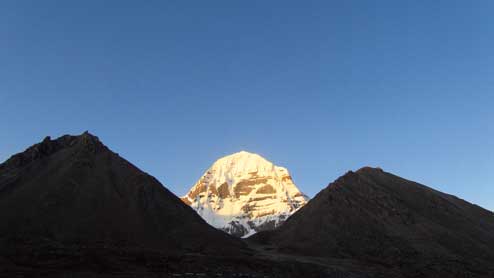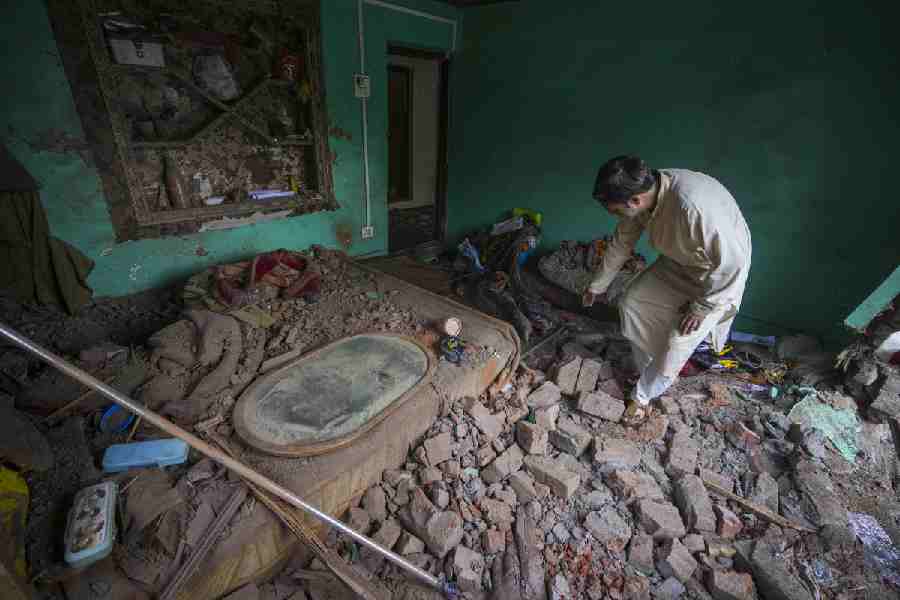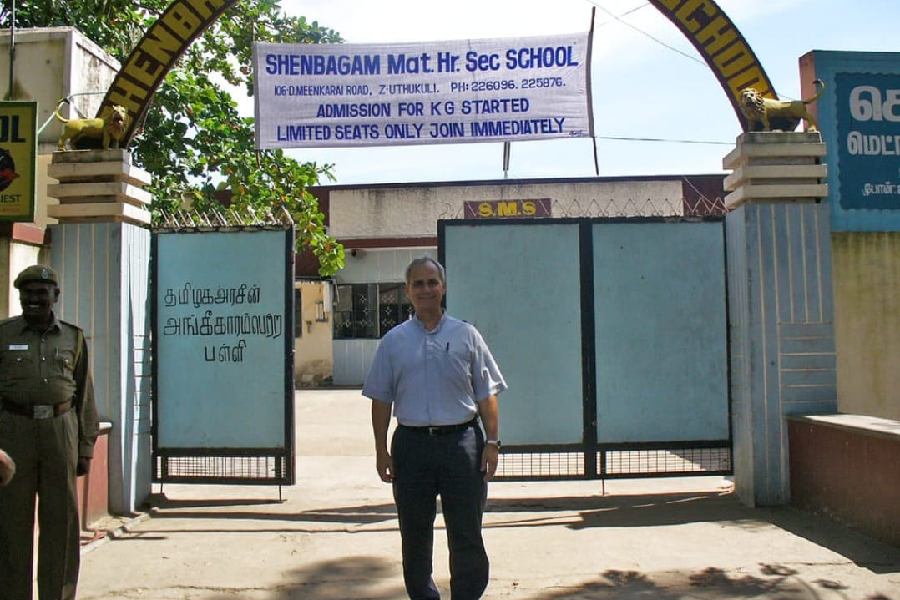
Bowing at the feet of Mount Kailash — the abode of Lord Shiva for believers — and trying hard to fight the freezing gale piercing me to my elements, I murmured:
Perched in the fissure
Of Time and timelessness
Ripped and minced
By the sharp blades
Of weather
Nowhere to flee,
I seek thee.
In reply came an even fiercer gale, forcing my heavily covered body to surrender. Numbness followed.
Last month, Beijing halted Indian pilgrimage to Kailash-Mansarovar through the Nathu La pass because of the border stand-off in Sikkim. This is the story of my journey on this most ancient trek among them all. I was a part of the first batch of pilgrims this year to Kailash-Mansarovar via Hilsa in Nepal.
Rated as one of the three toughest for amateurs, it breaks many preconceptions and taboos and busts myths that we mortals of the plains often have the luxury to live within.

The trek around, or the circumambulation of, the most revered Mount Kailash, also known as Sumeru Parvat in ancient Indian mythology, is spread over three days, two nights and 42 kilometres of the most inhospitable terrain of extraordinary solitary beauty. In practice though, numbers are inconsequential. What ultimately matters is every slow and laboured breath you take, especially if you have chosen to trek in sub-zero temperatures in early May — as I foolishly did — with one agonizing breath after another reminding you of the high altitude you are in. But more of that later.
Of the many routes to get to Darchen in Tibet, which is the base camp for the Kailash parikrama, the shortest are via Lhasa-Ali and via Lucknow-Nepalgunge, which is the one I took.
NEPALGUNGE-SIMIKOT
The fun starts in a small airplane that flies over three bulky mountain ranges, trembling just a bit in the high winds in a most picturesque ride dotted with tough little clusters of huts in remote regions towards Simikot; a tiny tabletop public airport nestled under snow-capped mountains just across the runway on the one end, and a sleepy small village town on the other. Here is where the altitude acclimatising starts, with cold nights. Time is best spent trekking uphill at Simikot, and checking how breathless one gets. The staying arrangements are frugal and a stark reminder of what’s in store.

SIMIKOT TO HILSA
An even tinier chopper takes us further up to Hilsa, the border between Nepal and the Tibet Autonomous Region of China. Hilsa shocks the vision with its grey and brown barrenness in sharp contrast to the lush green hills of Simikot. It’s barely a settlement of a few flat-roofed stone huts, clearly just a transit point to the other side, where unblinking Chinese guards insist on checking every phone and camera for “objectionable” visual material. Perhaps this strictness was because we were the first group to head to Mount Kailash in 2017.
HILSA TO TAKLAKOT
The road winds up to Taklakot at 13,200ft. In comparison, Kedarnath and Leh town are both at 11,200ft. Here’s where the lungs start complaining if one insists on walking “normally”, which in plains-speak means hard strides. And here’s where patience comes into play. Walk, climb, talk and be, but be slow, and happy you shall be. Run up the steps and you almost collapse.

TAKLAKOT TO RAKSHAS-TAAL AND MANSAROVAR
The big day arrives and we zoom on smooth roads to Rakshas-Taal, perhaps known best as the saltwater body in whose bosom lies the origins of the mighty Sutlej. As the rippling blue waters come into view, the beautiful Mount Kailash glistens in the distance. This first sight, especially on a glorious sunny day, is unforgettable. Everybody runs, phone cameras in hand, and soon becomes breathless. We’re at more than 15,000ft.
The grass is certainly not grassy. I bend down to these ugly mossy clumps and instantly reverse my judgement. Brave is the grass that dares to grow at this altitude and under this harsh sunlight. At its very base it is green, up to a centimetre perhaps. Thereon it struggles in oxygen-deprived air, hardly growing vertically; instead it spreads out and is bleached straw-white or tanned purple-grey. Yet, it grows, however much it can, in such adversity. I will remember this tenacity all my life.
An hour later, we reach the gorgeous Mansarovar, a water body of supreme significance to almost a quarter of the world’s population.
Little tents are put up as changing rooms for women and slowly some of us wade into the waters. The day is glorious; miraculously the biting cold seems to have disappeared. Chants and clicks abound.
Soon, the buses circumambulate Mansarovar and head to Darchen, the base camp for the trek to the Living-Mountain-that-is-Mahadev.
(1).jpg)
DARCHEN AND THE YAM DWAR
At 15,100ft, Darchen is a little town literally lorded over by the towering Kailash. The biting cold and sharp winds send us scurrying into little rooms with generator-dependent electricity. Yet again I am reminded of the folly of this trek during a cold, snowed-in May.
Dinner is served hot but nausea, headache and the lack of oxygen are already playing tricks, irrespective of age. Some of the older ones are much better off than those younger; perhaps it is constitution and fitness rather than age that determine one’s ability to adapt to the harshness around.

The cold is unabated the next day. The stripes of Mount Kailash seem aloof yet pulsating. It has been decided that the majority of the group shall bus it up to Yam Dwar and return to the guesthouse to wait till the trekkers return. Dropouts due to illness had started at Mansarovar and shall continue in the days to come.
Passing through Yam Dwar signifies the symbolic shedding of one’s mortal life and moving on towards the pradakshina (circumambulation) of Kailash, considered in mythology as the Axis Mundi or the Naval of the World: the point where Heaven and Earth meet.
THE TREK BEGINS
The Crown of Kailash seems close and will remain on our right as we trek upwards to Derapukh at almost 16,000ft, a distance of 14km with the toughest stretch reserved rightly for the last. Else, the faint-hearted would give up at the beginning itself!
Frozen waters on the left and the brown, cold desert of the Nandi Parvat on the right hem the mountain trail. Nestled within the Nandi Parvat is Kailash Himself. The beauty of the first day is that the trekker is closest to Kailash in these 14 kilometres. I feast my cold, blurry and watery eyes on Him throughout; at some points on the trek it seems that He is looming so large and close that touching him would be barely a stretch away.
There are two tents on this trek, Tea Shop One and Two, meant for rest and yak butter and saltwater “chai”. The wind chills to the bones despite layers and layers on us and my breath is warm with a low fever I’ve been battling silently for three days now. The trek is truly solitary, with each soul making its quiet way upwards; those that were ahead lag and then catch up again, soon this count is lost; all one can think of is the no-option one-amble-at-a-time ascent towards Derapukh, where Mount Kailash is only 200 metres away.
The maroon Derapukh monastery comes into view during the last hour of the climb that requires every bit of fortitude. Soon our huts, lined up simply with six flat wooden beds each, are a welcome collapsing point for all those who have braved altitude and elements.
I too collapse, but unlike others, I’ve untied my boots. I thank my rigorous fitness regimen, without which I would perhaps have become a Kailashvasini!


SUN-DRENCHED KAILASH
The next morning has probably been imprinted in my brain as my most lasting memory. As I step out of my tent, a glorious sun-drenched Kailash welcomes me, the air crisp, clear and still very, very cold.
Little rivulets of water flow downstream from Kailash. They are the only point of contact between Him and us, since no human dares to touch Kailash. They remained frozen the whole time, except a few odd minutes when they miraculously melted, perhaps to fulfil my wish of dipping my hand in the virgin waters, free of all pollution whatsoever. If there could be a moment where feelings overwhelm sanity, it was this.
Soon we learn that the authorities have denied us a permit to continue upwards to Dolma La since it is still snowed under. Never before have disappointment and relief cohabited so well. We sit back, gazing and soaking in nature’s most primitive sights before descending to Yam Dwar.
IN RETROSPECT
If there’s a trek where the power, empathy and beauty of nature are all-consuming, it is this. If there’s a trek where ritualistic religion turns to spirituality, it is this. Where not having a bath for days before prostrating to the Divine is a rule. If there’s a trek that proves that the most beautiful temple on earth is this earth itself, it is this.
I know now that I will go back another year to complete the circumambulation. I know now that whatever be the politics of big nations, this ancient trek will prevail.
Swati Gautam is an entrepreneur and a traveller at heart











